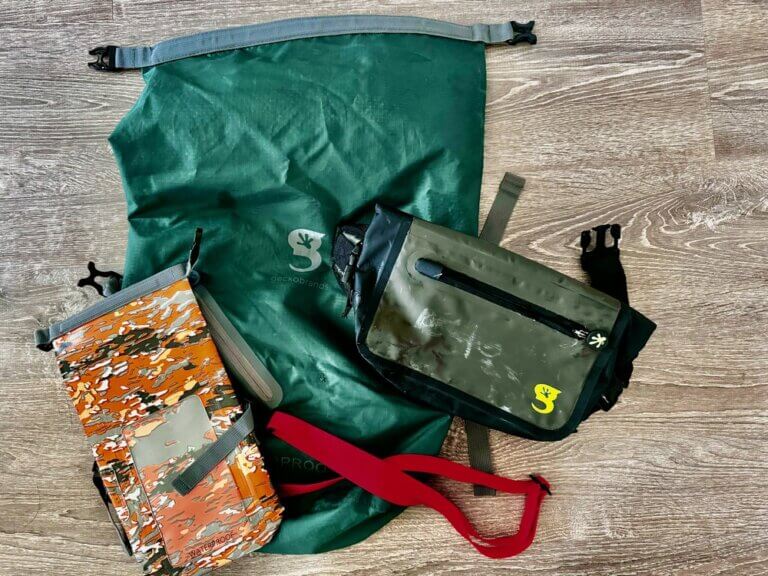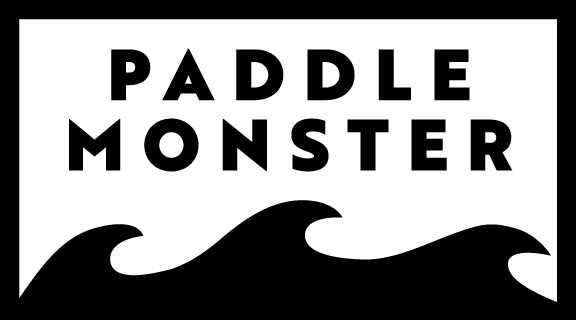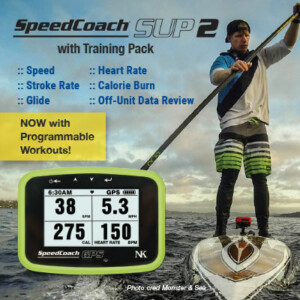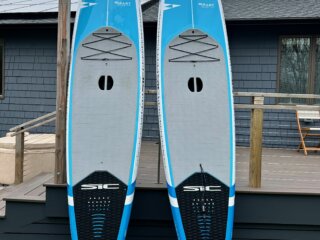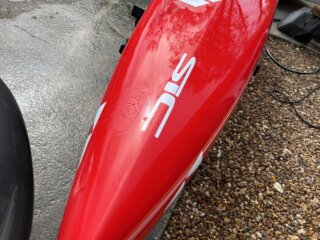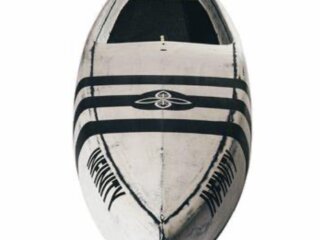
Staying “Inside” the SUP Board
In last month’s issue we looked at the most common technique errors and fixes associated with the catch, the part of the stroke where the blade enters, gathers water and begins to pull. In this issue we’re going to take a look at one of the most common errors people make when paddling SUP – keeping their body weight inside the board and failing to get it on the paddle. It limits the ability of the paddler to get the board “on top of the water” where it has less resistance to forward movement as well as limits their ability to compliment the work being done by paddling muscles with body weight and the force of gravity acting upon it.
We’ll look at this issue in detail using the same format we used last month and will use in coming issue when discussing technique errors and fixes, namely:
- What is the issue?
- How do you identify this problem in your stroke?
- How do you identify this problem in others or on video?
- How to correct the issue.
Staying “inside” the board
What it is: Staying “inside” the rails of the board can best be described as the failure to get body weight onto the paddle during the stroke, instead keeping it fully on the board instead. The paddler doesn’t lean outside the rails of the board at all where body weight must be supported by the paddle, and instead cautiously keeps his/her weight centered squarely over the feet.
This negatively affects a number of things including:
- one’s ability to track their board straight
- stability
- the ability to get the board sitting high in the water
- the amount of power that is generated in the stroke
When we stay “inside” the rails of the board with our body weight (think of all your upper body weight being over your feet) our top hand is usually situated inside the board as well, positioned approximately over the center line or long axis of the board. As a result of this the paddle blade, rather than being tucked right up close to the rail is further from the side of the board than it should be. You’ll see a noticeable gap between the rail of the board and where the paddle enters the water. This increases the turning effect of each stroke, making it more difficult to track straight.
Because body weight centered over our feet is inside the rails of the board rather than being loaded onto the paddle blade, the board is for all intents and purposes floating almost all of our body weight all the time through the stroke. This means that the board sits deeper in the water than it would if we were able to get some of our weight off the board and supported by our paddle when it is buried.
Of course, a board that sits deeper in the water has more wetted surface and therefore more resistance to forward movement. In effect, it’s plowing through the water rather than skittering across the surface as it would be if we could get it sitting higher in the water. This makes the board slower and makes it more difficult to sustain speed. It makes the stroke more difficult and fatiguing to pull. It also makes us less stable as a board that sits deeper in the water gets pushed around by waves more than a board sitting higher in the water, which is more likely to “skip across the top of the waves” instead of being pushed around by them.
Staying inside the board affects stability in another way. If you can get weight off of your board and onto your paddle it will give you something to “lean on”, as it can support a sizeable percentage of your body weight. We’re all familiar with a brace as a way to maintain stability when we lose our balance. By slapping our paddle blade flat on top of the water at our side, we can lean on it long enough to save our balance and regain stability. What many paddlers don’t realize is that the catch is a lot like a brace. If our blade is supporting our body weight as we gather water on it at the catch then it is serving the same function as a brace does with respect to stability. If we don’t get weight on our paddle at the catch and our weight remains entirely inside the rails of the board, we become a lot like the mast on a sailboat. When the board wobbles, we tend to wobble with it. It becomes much harder to let the board move underneath you without you moving with it. So, when the board rolls in one direction we’re likely to either roll with it in the same direction or overcompensate by shifting weight in the opposite direction, risking losing balance to the opposite side and falling off the board in that direction.
Lastly, we need to remember that gravity is a force that acts on mass. If we can get some of our body mass outside the rails of our board, almost to a point where we feel like we are going to fall in if the paddle does not take our body weight, gravity will act on that mass and effectively add to the forces our muscles are exerting against the water loaded on the paddle. We can use this effect to either make our stroke more powerful, more sustainable or some combination of the two.
Clearly, there is a lot that’s lost if we fail to get our body weight off the board and onto our paddle by staying inside the rails of our board. Now that we understand the issue, let’s look at how to identify it.
Identifying this problem in your stroke: There are a few telltale clues that you might be staying inside the board when you’re paddling. If any of these describe the way you feel when you’re paddling it is worth getting some video taken to see whether in fact staying inside the board is a problem.
If you feel unstable when you venture the weight of your upper body anywhere other than centered directly over your feet and so are reluctant to try to apply body weight to your stroke, you’ll very likely be staying inside the board when you’re paddling. If all of your weight remains over your feet to maintain stability you are by definition staying inside the board. Ironically, the very thing that you attempt to do to feel more stable (keeping your weight centered cautiously over your feet) leads to you actually being more unstable because the best way to gain stability is by getting weight off your feet and onto your paddle so that it can support you. Also, if you’re getting more body weight onto the paddle during the stroke you’ll be going faster, and speed helps with stability as well. If you find you feel really unstable in even the tiniest ripples on the water, you’re not getting enough weight on your blade are likely staying inside the board. What you want to actually be doing is getting a good portion of your weight above the waist off of your feet and on top of your paddle.
If you’re reluctant to move around on your board, there is a good chance that you’ll be keeping all of your weight over your feet when you’re paddling as well.
If you’re having a difficult time tracking your board straight and find you can only take a few strokes before needing to change sides to steer, it is also highly likely that you are staying inside the board. What is likely happening in this case is that your paddle is entering the water too far from the side of the board because your top hand is too far inside the board, increasing the turning effect of each stroke.
If, when you paddle beside someone else, you feel their board surges forward much more every stroke than yours, there is a possibility that you’re staying inside your board more than they are. Also, if you don’t see noticeable changes in your nose wave from the catch to the pull to the exit, then through the recovery to the next catch, there is a good chance you are staying inside your board (see “Visual and Auditory Cues to Good Paddling” in this issue for more on what the nose wave can tell you about your paddling).
In all of these cases, look to see how far from the rail your paddle blade is when it enters the water. If it is anything other than tucked right up against the rail on a consistent basis then there’s a good chance you have a problem that needs some attention. Now, look to see where your top hand is when you’re catching. If your paddle blade is away from the rail, it’s almost a certainty that your top hand will not be over the rail (or better yet over the water) but instead over the inside of the board. Rather than seeing their top hand extended in front of their face, most people with this issue will see it extended more to the inside of the board and perhaps even over the center line of their board. These are all telltale signs of staying inside the board. If you see any of these signs in yourself while you’re paddling it’s a good idea to take some video and get a better look.
Identifying this problem in others or in yourself when looking at video: If any of the scenarios mentioned above seem to apply to you and you’ve looked to see if your top hand is inside the board when you’re catching, it’s worth asking someone to take some video of you so you can get a better look. This issue is a lot easier to identify from outside through video than it is while paddling yourself.
As described above, look to see where the blade is relative to the side of the board when it enters the water. If you can see a gap between the blade and the side of the board when catching it is a problem. Look to see where the top hand is at the catch. You’ll be able to assess this best in video taken from straight in front or behind. If the top hand is over the board rather than over the rail or over the water it’s a problem that requires attention.
Most paddlers are able to get off the board and onto their paddle in the middle of the pulling phase. If you look at the video and focus on the middle of the pull, you may see that the top hand is over the rail/water. In this case the paddler has managed to get their weight off of their feet and onto the paddle for this part of the stroke. However, this doesn’t mean that they are doing the same thing at the catch. The idea is to get weight off of the board and onto the blade as soon as possible, right from the catch. This will lift the board out of the water sooner and provide more acceleration earlier in the stroke. Then the weight that goes on the paddle during the middle of the pull will just build on what was started at the catch, providing a much more powerful stroke that sees the board continuing to rise in the water as it continues to accelerate.

Figure 1 shows a paddler with their top hand inside the board and the paddle blade well away from the board at the set up just before the catch. Note the position of their top hand and corresponding position of where their paddle blade enters the water in figure 2. If you’re in this position you’ll be inside the board as you gather water on the blade and begin to pull.

If you see that the top hand is inside the board at the catch it’s a problem. In addition to not providing the lift and acceleration described above, the blade will be further from the rail (and therefore further from the center line of the board) meaning that immediately upon catching there is a greater than desired turning effect to the stroke making tracking straight much more difficult.
Another thing to note is the position of the upper body in relation to the hips and feet. If you see that the paddler is standing up straight, with hips stacked above the feet and upper body and head above the hips, there’s a problem. In this case, all the paddler’s body weight is stacked over the feet, meaning none is outside the board and on the paddle. Note how in figure 3 the paddler has all of his body weight essentially stacked on top of his feet rather than some of it outside that base of support and leaning over or toward the water.

If you notice any of these things in the video you’re analyzing then there are steps that need to be taken to fix a fairly major problem.
Correcting the issue: The most critical thing in correcting “staying inside the board” is getting weight off of your feet and onto the paddle. We can consider this from two perspectives:
1. As seen from the side (or along the length of the board)
2. As seen from the front or back (or across the width of the board)
The corrections that need to be made along the length of the board are the same as those described in the discussion on “taking too long to bury the blade” in the post “SUP Technique Errors and Fixes part 1 – The Catch” in the August issue. Please refer to that discussion. You’ll be trying to get weight off your feet by moving it forward, so that your center of mass is slightly in front of your body. This will put you in a slightly unstable position as you extend forward to catch that will require that your paddle support your body weight as it enters the water in order to keep you feeling stable on your board.
Corrections that need to made across the width of your board are described below:
- Think about crunching your paddling side rib cage and hips together: To get upper body weight off of your feet and over the water you’re going to have to lean from waist over the water. The easiest way to do that is to think about crunching your paddling side rib cage and hips together in an almost identical fashion to the way you’d do it when doing side crunches for your external obliques in the gym. Figure 4 is from Seychelle’s Instagram, showing how much improvement can be gained through using this fix.

This alone will get a good amount of your upper body weight off of your feet and edge it close to the water on the paddling side, but will likely won’t be enough to completely address this issue. You can get easily get a lot more weight off the board and onto the paddle with the next correction.
- Use your hips to counter balance weight the goes over the paddling side: You’ll recall when we discussed “Sitting in the chair” in “SUP Technique Errors and Fixes Part 1 – The Catch”, that using the hips to counter balance forward movement of upper body weight as we reach results in less weight going on the paddle. This is true when we consider body weight transfer along the length of the board. However, when we consider using our hips to counter balance across the width of the board it turns out that it does not have the same negative effect. It actually facilitates positioning of the upper body in such a way that it allows our entire paddling side including bottom shoulder, head and even top shoulder, to get over the water where the weight of all that body mass can be loaded onto the paddle.
The key to getting in this position is keeping weight evenly distributed between both feet so that the board doesn’t lean (unless you want it to for a steering correction). You’ll need to be mindful of this weight distribution as you experiment with using your hips in this fashion.
A good way to visualize what you want to with your hips is to consider what you do when you have your hands full and want to shut the car door. You position yourself in such a way that your hips are beside the door and then sort of hip check the door shut. Doing this same motion and then maintaining it while you extend forward to catch should help you get your body into the right position.
You’re basically trying to get into a position where your shoulders are no longer in the same horizontal plane beside each other but instead are “stacked” with the inside or top shoulder almost over the bottom shoulder in the vertical plane as you are about to catch. Your head should be directly over your paddling side shoulder such that you are looking straight down your paddling side arm towards your bottom hand.

Figure 5 shows me in this position as I am is setting up to catch the water. Note how my paddling side is “hanging over the water”, my shoulders are “stacked” and my head is over my paddling side shoulder.


Figure 6 and 7 show me in the same position as I catch and once the blade is completely buried. Figure 8, from Danny Ching’s Instagram, shows him in this position with the blade completely buried as he is beginning to pull after completing the catch. These are the positions you’re trying to achieve and should be seeing when you look at yourself on video.

- Think about “reaching to catch” and catching the water with the entire paddling side of your upper body: As you extend your paddling side hand forward to the catch (reaching to catch), it will help you add in hip and shoulder rotation such that your entire paddling side is extended. Then, if you’ve used your hips to counter balance as described above you’ll be able to get into a position where it feels like your entire paddling side is stretched out and hanging over the water. When you catch in this position it is almost like your entire paddling side becomes involved in the catch with all of its weight in position to load onto the paddle. Figure 6 really demonstrates this well.
There are two things I think about that I find helpful in achieving this position. The first is to try to open the angle between my paddling side arm and my torso (figure 9).

The greater this angle becomes the more I am exposing my paddling side, from my hips to my paddling side hand to the water and the more weight will get on the blade. The second thing is really just a visualization that helps open that angle. I try to visualize catching with my paddling side armpit, or if you want to look at it another way, the very top of my paddling side lat. When I catch well I can actually feel the muscles under my arm at the very top of my lat absorb some of the load as water gathers on my blade.
- Once you’ve completed the catch, continue to pile weight on the blade: If you’ve been able to execute the corrections described above at the catch, you’re doing great but you aren’t finished yet. You need to continue to load weight onto the blade through the pull until your blade angle is passing through vertical, at which point it is time to start unloading weight from the blade (we’ll talk about this in future issues). If you’ve got weight on the blade at the catch, continuing to pile weight onto the blade should feel very natural. It’s simply a matter of going with the flow that has been established. Figure 7 illustrates this very well. In this figure I have completed my catch and am into my pull and the photo clearly shows my body in position to continue to load weight on to the blade through the pull.
- Do not attempt to solve the problem by just moving your top hand across your body so that it is over the water: Simply moving your top hand across your body so that it is more over the water will not do anything to change the amount of body weight you’re getting on the blade. While it will make the paddle appear more vertical as seen from in front or behind and bring the blade in closer to the rail, this will only mask a problem that still exists. You’ll be getting no more weight on your paddle and will be putting your top shoulder in a compromising position. Trying to exert any pressure down the paddle shaft with your top arm in this position is extremely hard on your shoulder and risks a rotator cuff injury.
Figure 10 shows figure 1 with the corrected body positioning outlined above layered over top of it in green. Note that the paddle, seen in yellow, is completely vertical in this figure.

When you make these corrections, you should see an immediate difference in the characteristics of your board’s nose wave. Because you’re getting more weight on your paddle when it has maximum positive blade angle there is a greater lifting component to your catch. There should also be much more acceleration which also gets the board to sit higher in the water. These two things will combine to see the board climb higher in the water much more quickly and to a greater degree, resulting in the following changes to your nose wave:
- Nose wave will change color, becoming “whiter” rather than the color of the surrounding water
- Nose wave will move further back from the nose of the board
- Nose wave will become louder
The changes to the nose wave are all positive signs that you’re catching better, with more body weight on the blade and that your board is accelerating more and going faster.
If you use a GPS mounted on your board where you can see it, you should see that your board is moving faster. If you’re paddling with a regular training partner, you should get an indication of this improved acceleration and speed by how your board moves relative to theirs.
Lastly, when you’re paddling in rough water, if you are aggressive you should feel more stable as your paddle will be taking more of your body weight providing you with more to “lean on” (see “SUP Stability Tips for both New and Experienced Paddlers”)
Have fun playing with this extremely important part of the stroke and stay tuned for more tips in coming issues of The Catch!
Larry
Paddle Events
DeSatnick Foundation Around the Cape Paddle
Ohio River Paddlefest Races
The Circumnavigation-Tilghman Island 2024
Recent Classifieds
2 Boards: Both SIC Bullet 12’6″ x 28.5″
- Sell
- 12 hours ago
- Stand Up Paddleboard
- 02813 Charlestown , Rhode Island United States
- 13 views
SIC XRS 14 x 22
- Sell
- 4 days ago
- Stand Up Paddleboard
- Chattanooga , Tennessee United States
- 48 views
Wanted! Ocean / downwind 14 foot SUP
- Buy
- 5 days ago
- Stand Up Paddleboard
- Main Street , 07005 Boonton , New Jersey United States
- 47 views
one edge pro 2.0 hollow 14′ x 23.5”
- Sell
- 6 days ago
- Stand Up Paddleboard
- 53066 Oconomowoc , Wisconsin United States
- 89 views
2021 Starboard Allstar 14×24 5
- Sell
- 7 days ago
- Stand Up Paddleboard
- 21085 Joppatowne , Maryland United States
- 89 views
Subscribe for Premium Content and Coaching
Join the Paddle Monster paid Plan Today!
You May Also Like


Paddle Foundations: The Six Fundamentals of Paddle Technique
